1.- INTRODUCTION
Discussing or exchanging opinions are common situations in which we express and confront our beliefs and points of view. We do it naturally with the goal of convincing or modifying the opinions of others. In these common contexts: business, work, with friends or family, we debate when trying to find solutions to a complex problem or conflict, or to make decisions.
2.- COMPETENCES AND CAPABILITIES
The academic context is articulated as a vehicle for learning and personal development. Framed in a formal but at the same time playful context, students develop through debate personal competences and capabilities that are highly valued today both socially and in the business and organizational spheres. Among them stand out:
• Ability to organize and plan. Preparing speeches and debates within limited time makes us focus on the content we dedicate to each minute. With only 4 weeks allotted, individuals must efficiently search for information, synthesize context, and prepare speeches while being mindful of time constraints during presentations. This process helps in focusing on key points and learning to think, decide, and act effectively within time limitations.

• Generation of knowledge. Debating involves thorough preparation, requiring research and collaboration to develop various argumentative points. This process fosters both individual and collective learning. Through debate practice, one gains deeper understanding and language proficiency across multiple perspectives. Mastering verbal and non-verbal communication enhance persuasive abilities and convincing skills.
• Ability to generate new ideas, creativity. Debates often take unexpected turns, requiring improvisation and creativity. Despite preparation, discourse unfolds differently in response to rival arguments. Adaptability and creativity become essential in adjusting to unforeseen circumstances. To engage the audience and judges, one must tailor arguments and body language, necessitating creative skills for compelling interventions.
• Teamwork. Debaters must collaborate to ensure coherence in their team’s arguments. Individual preparation is essential, but collective review is inevitable to maintain an unified argumentative line. During debates, referencing and building upon each other’s contributions enriches interventions without repeating ideas, leading to enhanced group performance.
Interpersonal skills
• Self-criticism ability. Participating in team debates develops self-criticism skills. Recognizing mistakes as collective and accepting feedback from the jury promotes self-improvement. Evaluating both positive and negative aspects constructively enhances self-awareness.
• Self-confidence. Being part of a debate team helps to improve self-confidence because we expose ourselves and assume achievable challenges, overcome our limits, learn to win and to lose, or feel the support of our team.
• Empathy. In the dynamics of debate, teams must sometimes defend positions (the ones they are assigned) that do not coincide with their beliefs. This implies performing the exercise of positioning oneself in an uncomfortable stance and understanding what and how they think and feel to be able to defend that point of view with conviction.
• Research is vital for effective debating. It requires efficient information gathering to understand and articulate arguments on the debated topics. Becoming knowledgeable about the subject allows one to present reasons for or against a stance confidently.
• Capacity for analysis and synthesis. The skill of breaking down complex problems into essential elements and distinguishing the crucial from the trivial is essential. It involves establishing relationships between these elements, interpreting the problem clearly, and presenting it in an organized manner to aid decision-making. Synthesizing these elements into a cohesive message is crucial for addressing complex issues effectively.
3.- ORGANIZATION AND WORK DYNAMICS IN THE CLASSROOM
With the goal of improving students’ ability to express themselves appropriately in public through debate, a series of recommendations are proposed so that they acquire more confidence and security and are equipped with tools and techniques.
Organization of Debate in the Classroom
Debate in the classroom is understood as an educational tool complementary and supportive for the teacher. Its main objective is to deepen the acquisition and assimilation of knowledge in addition to increasing student involvement and stimulating critical thinking on the subjects worked on in the classroom.
Debate Format

The academic debate format is the most appropriate in university contexts since, unlike other models -British Parliament or Lincon Douglas- it develops research and the search for evidence for the preparation and justification of arguments in a reasoned manner.
It is a discursive genre that allows developing argumentative devices in students and allows scientific dialogue between peers; the organization of thought around a communicative and, therefore, persuasive intention and the recognition of the elements of validity, soundness and respect for the multiple visions of others, among others (Carrillo-García, S., & Castellanos, K. N., 2017).
Academic debate has been used as a technique to improve student performance and develop both subject-specific competencies and transversal competencies (critical thinking, effective communication, teamwork, practical thinking, knowledge of contemporary problems, ethical, environmental and professional responsibility) with very good results (Pellicer Armiñana, TM.; López Mateu, V.; Orozco Messana, J.; Giménez Carbó, E., 2022).

Source: own research.
Image 1. Debate Structure.
Debate Structure
The participating teams in a debate will defend opposite positions; one team will defend the “in favor” stance (pro team), and the other one the “against” stance of a premise (con team). The position to defend will be decided by drawing lots before the debate.
Opening speech
The opening speech kicks off the debate, laying on the team’s position and key arguments. It sets the tone, introduces the team’s position and gives the audience a roadmap to follow. Attention-grabbing techniques like an eye-opening fact, a powerful quote, or personal anecdotes are crucial to engage the audience.

Source: own research.
Image 2. Opening Speech.
First rebuttal
In the first rebuttal, the opposing team responds to the opening speech by challenging arguments, presenting counterarguments, and refuting points. It’s a chance to weaken the opposition’s position and demonstrate the speaker’s own arguments. Using the P-E-E-format (Point, Evidence, Explanation) helps structure arguments for clarity and persuasion.

Source: own research.
Image 3. First Rebuttal.

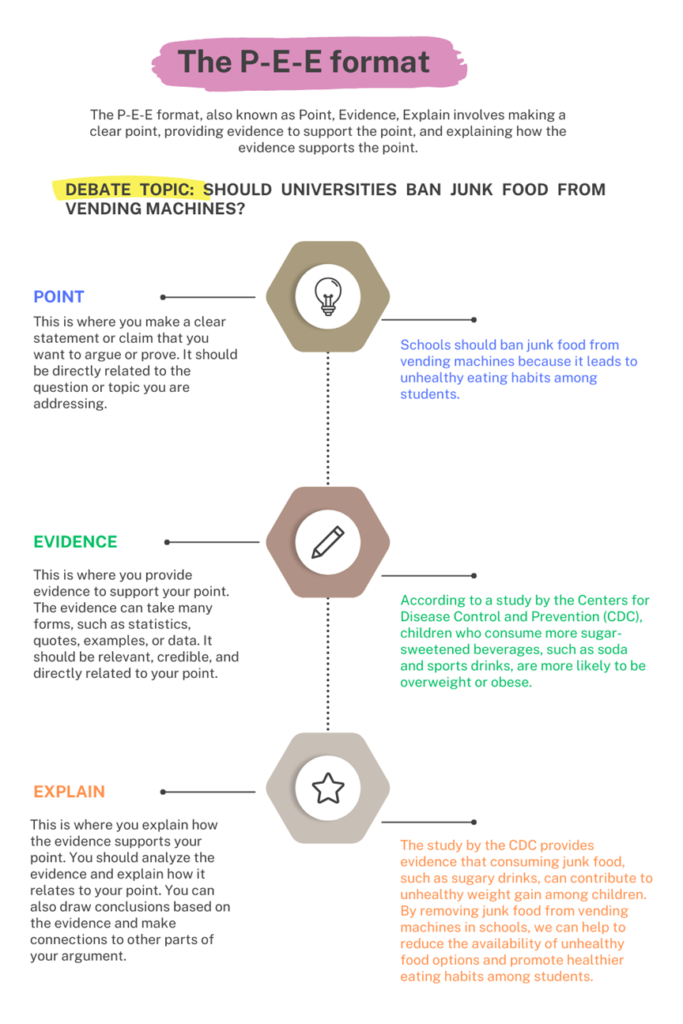
Source: own research.
Image 4. The P-E-E format.
Second rebuttal
In the second rebuttal, the speaker’s team responds to the first rebuttal by reinforcing their arguments, addressing counterarguments, and refuting points. It’s a chance to strengthen their position and highlight weaknesses in the opposing team’s arguments. Utilizing the P-E-E format helps structure arguments for clarity and persuasion.

Source: own research.
Image 5. Second Rebuttal.

Conclusion
The conclusion marks the end of the debate. The speaker summarizes main arguments from both sides, reaffirms their team’s stance, and delivers a closing statement. It’s a chance to leave a lasting impression, summarize key points, and make a final appeal. Using impactful techniques like summarizing main points and restating the team’s stance helps conclude the speech effectively.

Source: own search.
Image 6. Conclusion.
4.- DEBATE EVALUATION
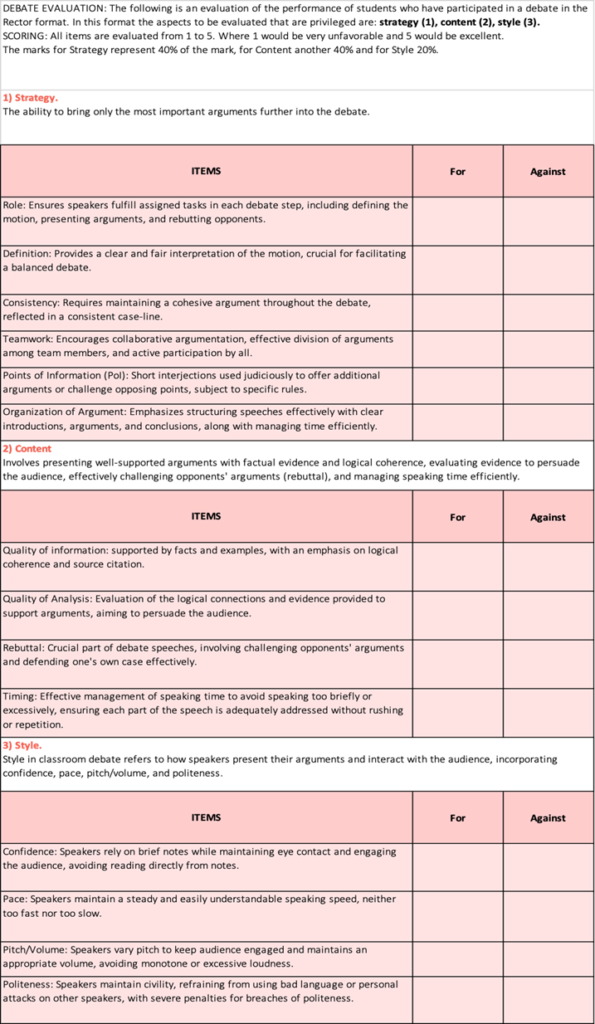
Source: own search.
Image7. Debate evaluation: strategy.
5.- DEBATE TOPICS
Debate topics can be directly related to the theoretical concepts worked on in the classroom but should be controversial to avoid a one-sided discussion. Student interest is key, as it can motivate further research.

Source: own research.
Image 8: Tips for choosing debate topics.
Establishing participation rules before any debate fosters a participatory methodology, prioritizing student involvement. Key rules include:

• All opinions are valid. There are no good or bad opinions, only different ones. These must be supported by some evidence as much as possible.
• Respecting speech turns without interruptions.
• Manage the intervention times since interventions have a time limit.
EXERCISE


Guidance for information search is crucial once the debate topic is announced. Students should seek evidence to support arguments. Sources should be verified and realiable, including official statistics, expert opinions, studies, and research, to ensure well-prepared content.
To enhance public speaking skills, addressing both content and external elements is vital. This includes:
Guidelines to overcome stage fright and to manage nervousness and stress.
Understanding non-verbal communication basics.
Suggestions for the elaboration of speeches: how to make them interesting.
Problem-solving strategies: blanks and forgetfulness, slip of the tongue, stylistic resources.
EXERCISE

The teacher, as a guide, can prepare a list of open questions ranging from general to specific to steer or revitalize the debate. They can also provide mentoring through tutorials with debate groups to aid in preparation.

Source: own research.
Image 9. Creating effective questions.
It is advisable to use a classroom where tables and chairs can be moved aside to generate a space that allows visual contact among classmates and the freedom of movement of the speakers.

6.- THE ROLE OF THE TUTOR
As a moderator and energizer, the teacher evaluates student’s contributions to the debate and the achievement of objectives, providing feedback on individual and group interventions. Their roles include:
Observing and evaluating student interventions, compiling arguments.
Introduction of discussion topics.
Assessment of the ideas contributed by the students.
Summarizing group contributions for conclusion presentations.
Controlling the times of intervention, promoting active listening.
The teacher may use an assessment sheet to quantitatively and qualitatively evaluate interventions, emphasizing strenghts and weaknesses, proposing areas for improvement, and aligning with learning objectives. The assessment sheet can be designed based on the learning objectives set by the teacher.

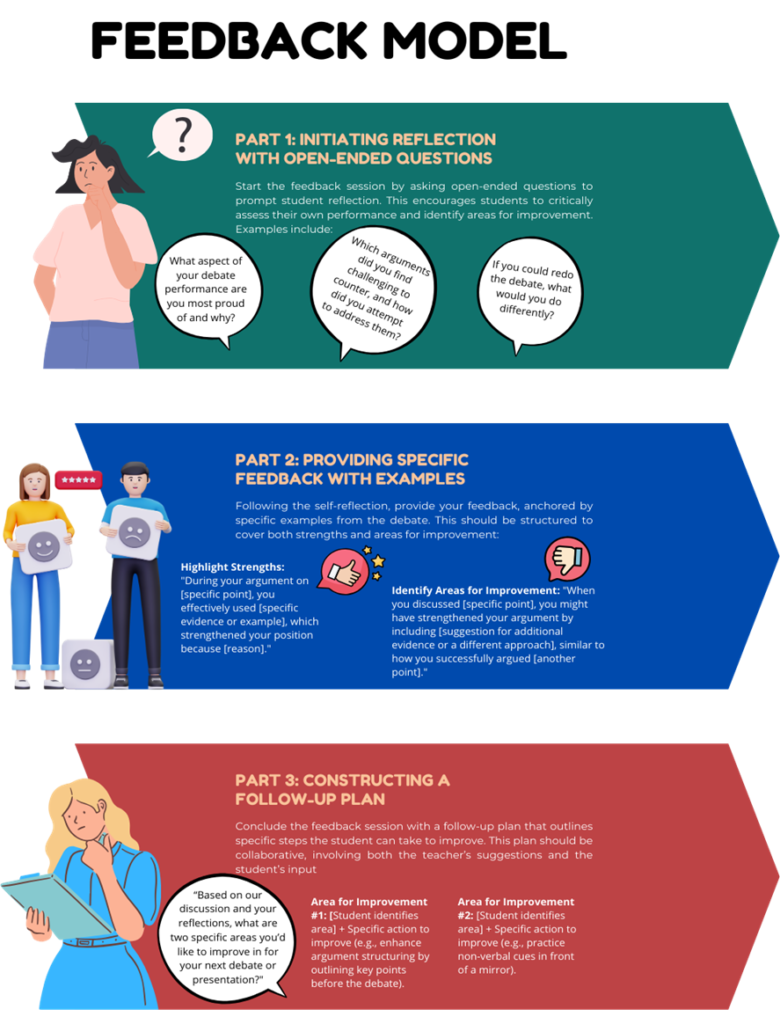
Source: own research.
Image 10. Feedback Model.
7.- WORK DYNAMICS
Next, various classroom work sessions are proposed to develop communication skills and competences in students.
SESSION 1. Creating a Trust Environment
Objectives
• Create an environment of trust and participation.
• Promote active listening.
• Manage situations of nervousness.
• Become aware of emotions.
Description

Creating a non-evaluative space for students to freely express themselves fosters their unique communication style. One activity involves paired students: while one expresses emotions (anger, disgust, sorrow or joy), the other maintains a neutral expression, focusing on controlled breathing. This helps students become aware of emotions, practice managing thoughts, and develop effective coping strategies.
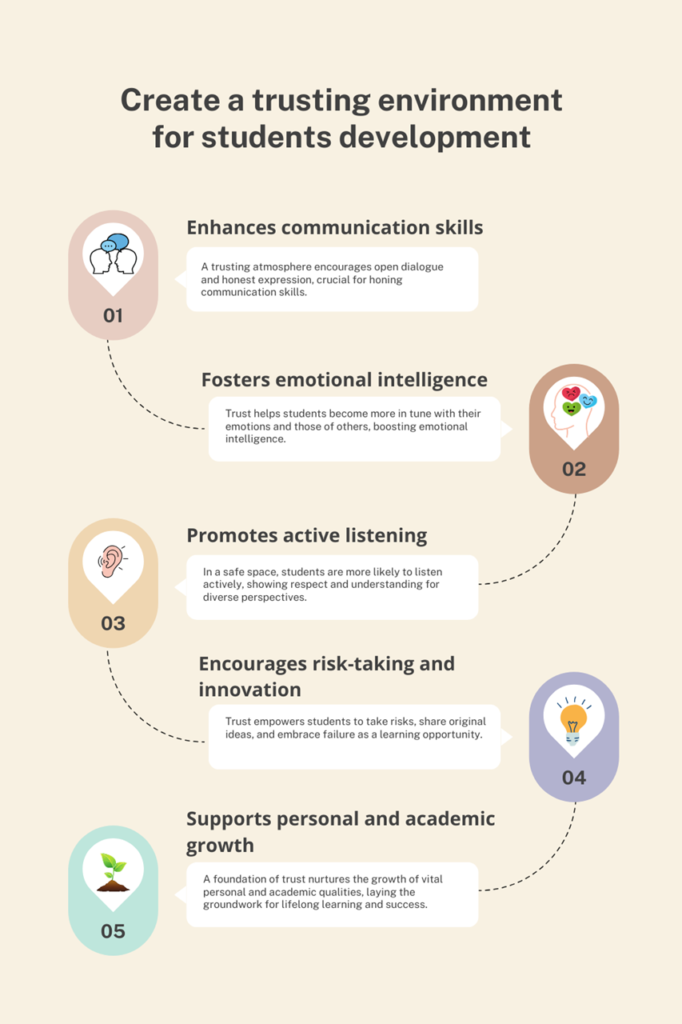
Source: own research
Image 11. Create a trusting environment for students development.
SESSION 2. Self-knowledge
Objectives
• Promote creativity and improvisation.
• Work on non-verbal language.
• Work on the structure of a speech.
• Develop attractive speeches.
Description
When speaking publicly, clarity on both objective and delivery is crucial. Students are tasked with improvied presentations lasting 3-4 minutes on emotionally charged topics like embarrassing moments or life’s highlights. They will prepare for 5 minutes, then deliver without interruptions or filler words (uh…, um…, well…). These exercises delve into personal experiences, enriching the classroom with life lessons, making oratory a tool for self-knowledge and personal growth.
Variants: Forbidden word. The classmates acting as the audience will raise their arm every time the speaker mentions the forbidden word, and he or she will have to start the speech over again.

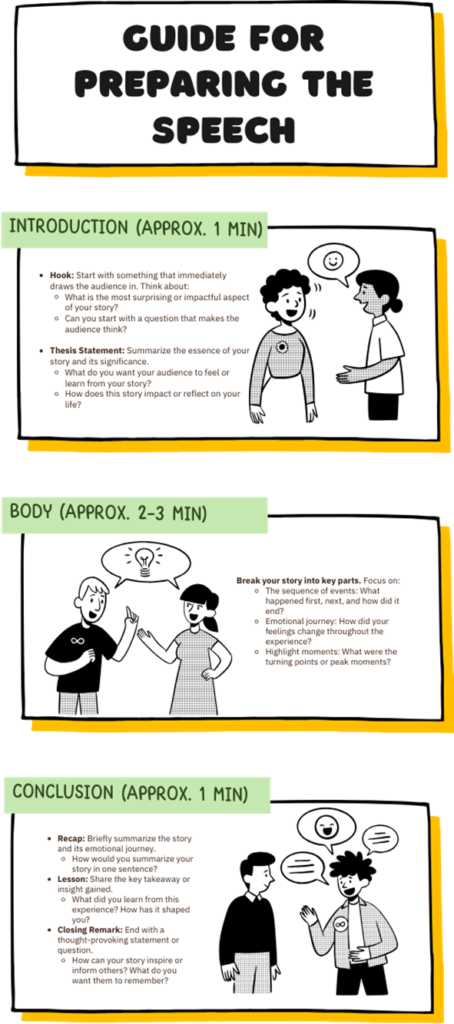
Source: own research.
Image 12. Guide for preparing the speech.
SESSION 3. Do We Know What to Say?
Objectives
• Work on different types of speeches.
• Improve both internal and external elements of the speech.
Description
During oratory training, mechanical skills will be acquired (speech assembly/verbal communication), training, and exercises in non-verbal communication (work with voice, gestures, looks, expressions, breathing, space, body, movement)
Students will deliver three presentations covering various speech types, aiming to identify strengths and weaknesses to personalized development and improvement.
Narrative or descriptive speech: Free topic: plot of a book or movie, personal experience…
Told in the third person.
Synthesis ability will be assessed.
Three-minute presentation.
Expository or informative speech: Topic: Biography of a significant character.
Informative tone and objective intentionality that must be translated into verbal, vocal, and gestural aspects.
Five-minute presentation.
Persuasive or argumentative speech: Free topic.
Ten-minute presentation.
Types of Speeches:
• Narrative or Descriptive Speech. This type aims to vividly portray people, things, or situations through storytelling and arguments. Utilizing sensory observations is crucial to express what is seen, heard, or read, creating a clear mental image for the audience. Precise linguistic and non-verbal expressions are chosen to convey observations accurately
• Expository or Informative Speech. This type aims to inform or clarify a topic without expressing opinions. The text should be clear, precise, and objective, maintaining focus without digression. A well-organized structure includes an introduction to set the topic, a development or explanation section, and a summary or conclusion to reinforce key ideas.
• Argumentative or Persuasive Speech. This type aims to persuade the audience by appealing to their logical understanding. It precedes conviction, relying on logic and conviction to convey reasons effectively. The structure includes an introduction to present ideas, a development section with reasoned opinions, and a conclusion to reinforce the initial idea.

Source: own research.
Image 13: Types of speeches.
EXERCISE: Identify the speech type
Read each speech carefully, taking notes on key characteristics that might indicate the type of speech (persuasive, narrative, expository). Consider the speech’s objective, the structure, the language used, and any persuasive techniques or descriptive elements. Use the template to identify them.


SOLUTION



SESSION 4. Argumentation
This activity introduces basic argumentation skills (giving orders, directly refuting arguments, etc.) and encourages participation in the debate.
Objectives
• Elaborate and present different arguments related to the proposed debate resolution.
• Adequately manage the times of intervention.
Description
Students begin by researching a topic with two opposing positions. They sit in a closed circle, initiating a chain debate. Starting with a volunteer or the teacher, each student adds an argument either in agreement (“And”) or disagreement (“But”) with the preceding point. Original ideas are crucial, avoiding repetition. The debate concludes once each student contributes, and a new topic can be introduced afterward.
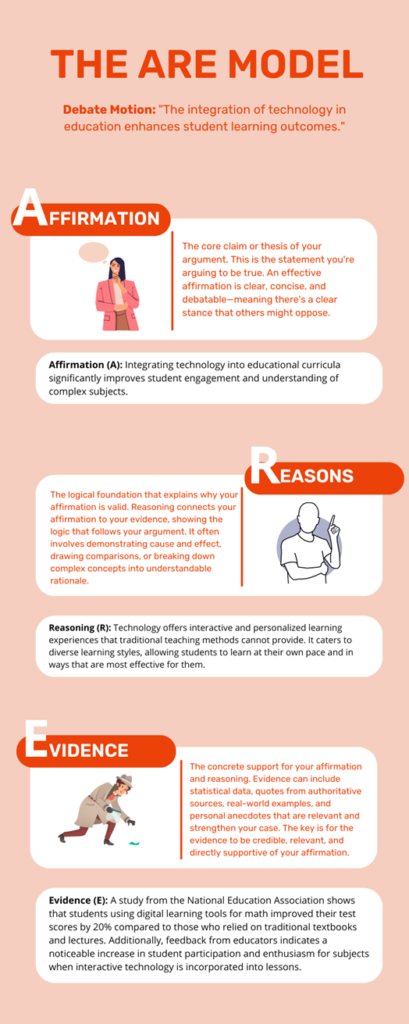
Source: own research.
Image 14. The ARE model.
SESSION 5. Evidence
In this session, the aim is to work on the elaboration of arguments using evidence as a starting point. This dynamic delves into the elaboration of arguments and evidence, where to look for it and how to use it to support an argument.
Objectives
• Elaborate and present different arguments related to the proposed debate resolution.
• Identify the main argument of evidence.
• Develop public speaking and leadership skills.
Necessary Material
• 3 to 8 pieces of evidence (articles, expert opinions, studies, statistics…) related to the proposed debate topic.
• Cards with different positions about the debate topic (e.g., in favor, against, intermediate stance).
Description

A topic for debate is chosen, and students form groups (up to 4 members). Each group receives evidence related to the topic along with a position card (in favor, against, or neutral). They have 20 minutes to develop arguments corresponding to each piece of evidence and their assigned position. Groups then present their arguments. Following presentations, a rebuttal session allows groups to question each other.

Source: own research.
Image 15. Evidence in arguments.
SESSION 6. Refutation
This activity works on the basic technique of refutation based on a 4-step intervention. In this way, students will work in a group on a model of direct refutation.
Objectives
• Develop skills in direct refutation.
• Develop skills in constructing arguments as a group.
Description
The class is divided into groups of 4 members. Each group is provided with an argument to refute (e.g., Customer opinions on the Internet should be limited). Students must work in a group to refute the argument using the 4-step refutation. Then, they will present the refutation in which each group member will perform a step:
• Member 1: Summarizes the argument in one sentence.
• Member 2: Summarizes the counter-argument in one sentence.
• Member 3: Provides evidence and/or analysis supporting the counter-argument.
• Member 4: Explains why the counter-argument is superior to the argument and what are the implications of the counter-argument for the debate.
Once the group’s intervention is finished, the rest of the class can examine the points presented.
Complementary Variant
After explaining and practicing the 4-step refutation process, students receive evidence and imagine it being presented by their opponent in a debate round. They write an ideal refutation using the 4-step model within five minutes. Volunteers then present their refutations in one minute.


Source: own research.
Image 16. 4 Steps to Refutation.
EXERCISE: Refutation task
Refute the following argument that telecommuting decreases the cohesiveness and productivity of a team using the 4-step rebuttal process:
“Remote work hinders team cohesion and overall productivity within organizations. Team cohesion is built on frequent, spontaneous interactions that are more naturally occurring in a physical office environment. These interactions foster a sense of community and mutual reliance, which are critical for team productivity. A survey conducted by the Harvard Business Review in 2021 found that 65% of companies reported a noticeable decrease in team cohesion after shifting to remote work, which corresponded with a 30% drop in overall productivity.”
RESPONSE

8.- BIBLIOGRAPHY
Alén, E., Domínguez, T., & de Carlos, P. (2015). University students׳ perceptions of the use of academic debates as a teaching methodology. Journal of Hospitality, Leisure, Sport & Tourism Education, 16, 15-21.
Arrue, M., & Zarandona, J. (2021). El debate en el aula universitaria: construyendo alternativas para desarrollar competencias en estudiantes de ciencias de la salud. Educación médica, 22, 428-432.
Manual para Jueces y Debatientes (2019) CMUDE Perú. En: https://formaciondebatecom.wordpress.com/wp-content/uploads/2020/03/manual-para-jueces-y-debatientes-cmude-peru-2019-2.pdf
Moncalvillo Boracho, S. & López Pérez M.C. (n.d.) Manual de debate. GUÍA PARA REALIZAR UN DEBATE ACADÉMICO EN EL AULA. Junta de Andalucía. En https://www.juntadeandalucia.es/educacion/portals/delegate/content/0b87e7f5-f5b3-4231-abfa-7741398912c1
Preci, C. (2014). La enseñanza de oratoria en el aula. El método de autoconfianza. Reflexión académica en diseño y comunicación, 23.
Rief, J. J., & Schrader, B. J. (2024). Debating About, Against, and With ChatGPT: Redesigning Academic Debate Pedagogy for the World of Generative Artificial Intelligence. In The Role of Generative AI in the Communication Classroom (pp. 87-105). IGI Global.
Zare, P., & Othman, M. (2015). Students’ perceptions toward using classroom debate to develop critical thinking and oral communication ability. Asian Social Science, 11(9), 158.


